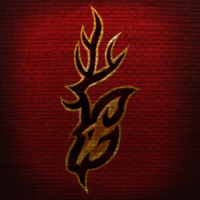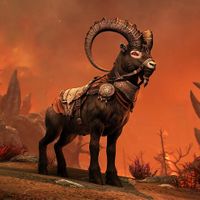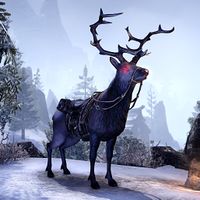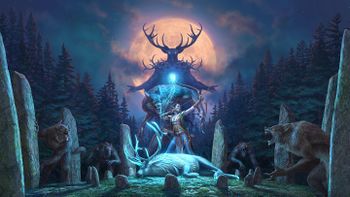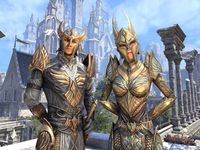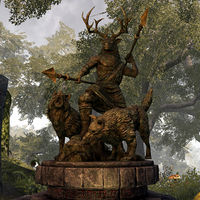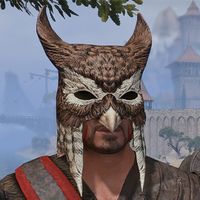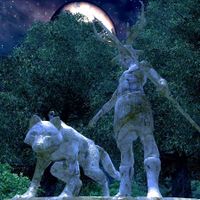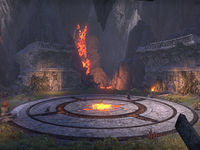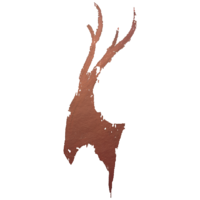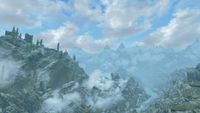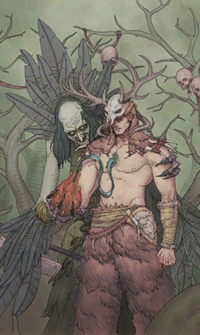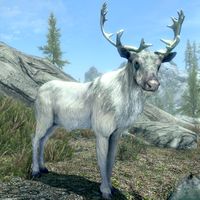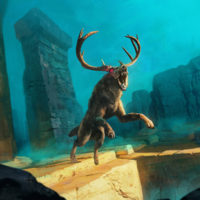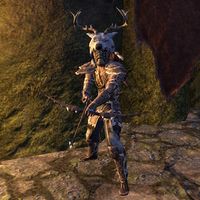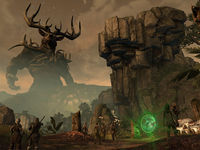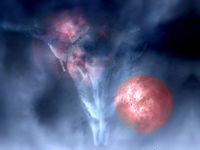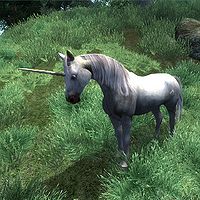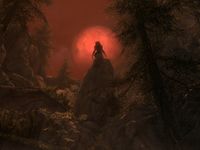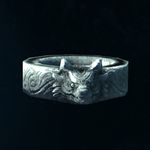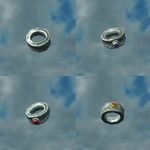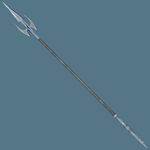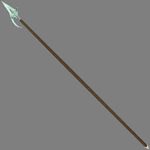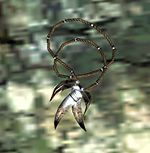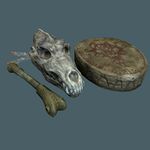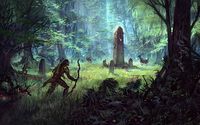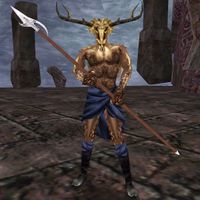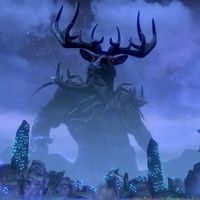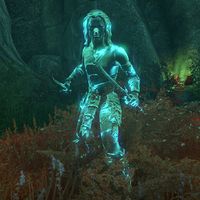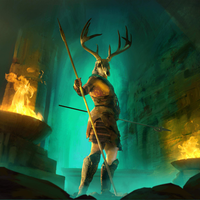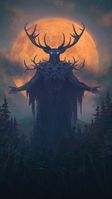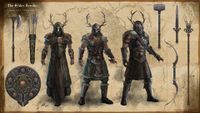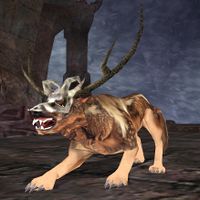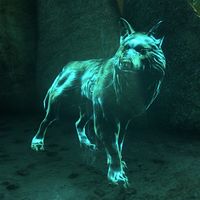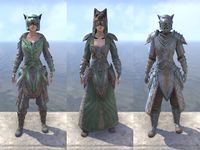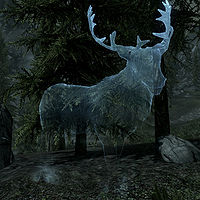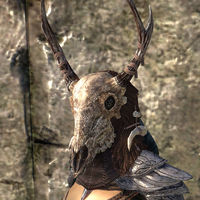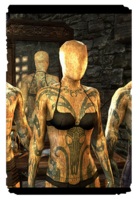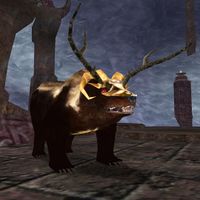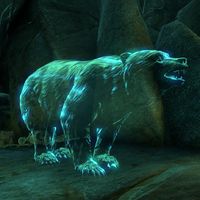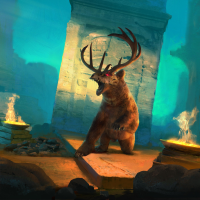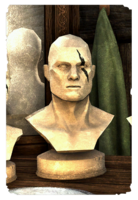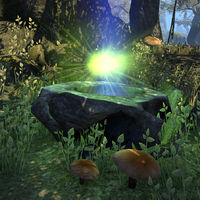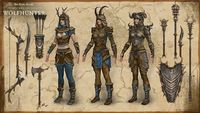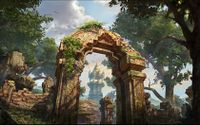Lore:Hircine
Hircine, known as the Huntsman, Lord of the Hunt,[1]:293 Master of Beasts,[2] and the Master of the Chase,[3] is a Daedric Prince whose sphere is the Hunt, the Sport of Daedra,[4] the Greatest Game, and the Chase and Sacrifice of Mortals.[5] His realm of Oblivion is the Hunting Grounds,[6] an endless forest where the Prince and his Huntsmen hunt great beasts, people, and even other Daedra.[2] Hircine is typically portrayed with a great spear and either the head or skull of an elk,[7] the latter of which Khajiiti myths say belonged to Y'ffer's champion, the Graht-Elk.[8]
Hircine is one of the more widely worshipped Daedric Princes in Tamriel, despite never actively seeking worship or reverence.[9] His appeal lies in his sphere, which encompasses the thrill of the hunt,[10] though this can be taken to extremes.[11][12][13] His advocacy for sportsmanship is another lure, as the Law of Fair Hunt which he holds to prohibits cheating prey (referred to as "the Hare") out of a genuine chance at escape.[3][14] He admires the Hare that overcomes whatever is thrown against them, no matter the odds. For example, one who turns the game on its head by hunting the hunters may earn the Prince's respect.[15] Finally, he is straightforward in his desires; he often seeks people out, tests them, and rewards those who prove themselves worthy with a boon.[9][16]
As the progenitor of lycanthropy, Hircine is recognized as the Father of Manbeasts.[17][9] He serves as the guardian of were-creatures, which are often referred to as his "children".[18][19][20] The condition is called Hircine's Gift by those that view it as a blessing,[17] and Hircine's Curse to those that consider it an abomination.[21] Hircine is quite prideful of lycanthropy, and resents those that received it willingly but have come to regret it; he's known to have ingrates slain to rid them of their misery.[22] Regardless of whether they worshipped him or not, Hircine will typically claim the souls of skinshifters, and they will spend eternity in the Hunting Grounds.[16][9]
The Demiprince Dearola is Hircine's daughter.[23] There is a belief that Hircine is allied with Mehrunes Dagon,[nb 1] though Lyranth the Foolkiller claims that if such an arrangement exists, it would be obscure outside their own circle.[24] Hircine has Daedra Lords that manage some of his sub-spheres and report to him, such as the Lord of Fishing.[UOL 1] He is also associated with the Daedra Lord Hollowjack,[25] whose realm of Detritus is a "carving" from the shell of the Hunting Grounds.[26].[26] Ebonarm is an enemy of Hircine.[27] Hircine's summoning day is the 5th of Mid Year.[28]
Aspects[edit]
The Reachfolk believe that there are five aspects of Hircine, each worthy of reverence.[19][29] Some believe there are more than five, however, as the Glenmoril Wyrd worships an additional owl aspect.[UOL 2] An aspect in the form of a ram dubbed the Great Dark Ram also appears during Rain's Hand in Cyrodiil's Great Forest.[30] Hircine's worshippers are known to craft their weapons and armor in a style that honors these figures.[31][32]
Alrabeg (the Hunter / Aspect of Guile)
Alrabeg is the hunter, and he bears the Spear of Bitter Mercy when he manifests.[19] On occasion, he wields the Spear of the Hunter.[33] He comes to Nirn to hunt new prey, or to bring prey native to the Hunting Grounds to the mortal plane. If he arrives without prey, then he has come to select a Hare in his next hunt.[19] Worshippers invoke Alrabeg's name when praying for a bountiful hunt.[3]
Storihbeg (the Manbeast / Skinchanger / Skinshifter / King of Wolves / Wolf Aspect of Hircine / Wolf That Craved the Sky / Wolf with the Daedric Howl / Aspect of Speed)
Storihbeg is the wolf, and wears the Wolf Skull Totem. Storihbeg introduced the gift of skinshifting to mortals to remind them that they can be predators, not prey.[34] When he comes to Nirn, he hunts with these skinshifters, or seeks to "adopt new children and turn them pelt-side-out"; that is to say, he turns mortals into werewolves. His howl is capable of freezing his prey's innards,[19] which when combined with his speed, makes it difficult for prey to flee from him.[35] An account from the Druadach Mountains tells of Storihbeg appearing as a wraithlike wolf composed of extreme storm and fog, and his arrival was proceeded by inclement weather. The account tells of him stealing the unwary during the night before vanishing. His terrifying Daedric howl was unforgettable; described as mournful, brazen, and unrelenting.[36]
Uricanbeg (the Great Dark Stag / Great Stag)
Uricanbeg is the stag. He comes to mate with hinds, and may transform a mortal woman into one for the same purpose. He may also arrive to cull the herd of the weak. His hooves drum the Blood Summons that lure prey into his herd, which are then led into the Hunting Grounds where they meet their end.[19] Some of his offspring have granted mortals the honor to ride them.[37]
Gulibeg (the Quick Fox)
Gulibeg is the fox. He shares characteristics with some cultural interpretations of Lorkhan. Like Lorkhan, Gulibeg is a trickster; at his worst, Gulibeg will deceive mortals into meeting their own demise, or will use his swift bite to weaken his prey.[38] He shows some parallels with Shor, the Nordic interpretation of Lorkhan,[39] whose totem is the fox.[40][41] Gulibeg's symbol is the Wand of Bone, which was fashioned from a shard from Lorkh's ribs, and has the ability to confound any mortal.[29] In one tale, a medallion associated with Gulibeg makes less conventional forms of communication understandable.[42] Gulibeg is said to reward those he finds clever by teaching them tricks and secrets,[19] which the Reachmen claim helped them survive the fall of Lorkh.[29]
Hrokkibeg (the Mighty Bear / Aspect of Strength)
Hrokkibeg is the bear. He embodies strength, and has ties to the Totem of Claw and Fang. He comes to Nirn seeking solitude, peace from labors, and renewal of the Burning Spirit Within. He may bless those that make offerings of mead with the power of the Bear-Heart. However, he will attack those who disturb his peace. Though he is slow, he makes up for it with his strength,[43] and tears his prey apart if he catches up to them.[19]
Worship and Culture[edit]
Afterlife[edit]
Hircine's devoted are promised an afterlife within the Hunting Grounds, a savage land that provides to its dwellers. Here, one can indulge in spectacular hunts. Those within the realm experience an endless cycle of violence, as well as death and rebirth. Its inhabitants reside in the many hunting lodges dotting the landscape. The forests of the Hunting Grounds are teeming with powerful beasts, which allow Hircine's followers to engage in the most spectacular hunts. To the faithful, the plane is a paradise.[9]
Hircine is the Master of the Great Hunt,[44] a grandiose contest that typically pits participants of the Prince's choosing against each other for his amusement. This event is a common occurrence in the Hunting Grounds, to which mortals are sometimes invited.[16] Outside of his plane, they are rare, rumored to happen only once in an era.[45] Hircine may call upon a Great Hunt on Nirn for his own merriment,[46] or to punish those that defy him.[9][47][15]
When the Great Hunt is hosted on Nirn, Secunda turns red, becoming the Bloodmoon, and the hunt proceeds until the Bloodmoon subsides.[45] The Bloodmoon is said to symbolize the blood of the Hunter's Prey, and those wishing to join the Great Hunt craft rounded bone pendants that are stained with blood to represent the event.[45][48] Should one emerge victorious from the Great Hunt, they are permitted to ask Hircine for a grand boon.[16]
Altmer[edit]
The Altmer detest anything related to the Daedra. They believe Daedra are not to be bargained with, and Summerset laws supposedly decrees that summoning them warrants a death sentence.[49] To wield Daedric magic is to insult one's lineage.[50] The Altmer are very zealous in their beliefs, that it warrants the existence of the Divine Prosecution, which is tasked with enforcing religious laws, and that includes stomping out any Daedra worship.[51] There is some leeway however as evident with the author of the book Liminal Bridges, and the organization known as the Thalmor utilizing daedric summons in combat.[52][53]
In the context of Hircine, thanks to the isolationist policies of the Altmer, they are vulnerable to the spread of lycanthropy. This became evident when Queen Ayrenn opened up the Summerset Isle to immigrants of other races.[54] Lycanthropes are a rarity on the Isle, and thus the Altmer were not familiar with how to best handle them. When the Bosmeri Thornfang Pack migrated to Summerset, they found it comparable to a safe haven, and were able to spread their "gift" with relative ease.[55] Summerset werewolves often collect and embellish the skulls of their most impressive kills. Indrik skulls are especially prized trophies.[56]
Altmer seeking to worship the Lord of the Hunt often look elsewhere to avoid persecution. One such individual was Lady Ghisiliane, an Altmer noble who held grand hunts away from Summerset, where mortals and exotic creatures were brought in as quarry. She ran a kidnapping ring to populate her hunts with fellow mortals. She invited the local elites of society, including other Altmer, to participate in her games.[11][57]
Bosmer[edit]
Hircine is a Daedric power of some significance among the Bosmer,[14] though their perception of the Hunter varies. While the Hunter's name may be invoked for luck in a hunt, going further can lead to cruel or violent extremes.[13]
In the Dawn Era, before Y'ffre's Naming stabilized the forms of most creatures,[58] life was stuck in a chaotic, ever changing state called the Ooze. From this Ooze, Y'ffre gave shape to the Bosmer, but forbade them from ever changing that shape through the terms of the Green Pact. The souls of those who violate the Green Pact would be condemned to return to the Ooze.[59] The only shapeshifting allowed by the Wood Elves' culture is during the collective ritual known as the Wild Hunt, which is only invoked in an act of vengeance or desperation.[59] The Bosmer believe that Hircine wishes to return to this chaotic state. As in other cultures, his cultists see shapeshifting as a gift, and view being culturally mandated to a single form as "tyranny".[UOL 3]
Bosmer can transform into a creature of the Wild Hunt outside the need for the collective ritual.[60] Doing so this way is not condoned by Y'ffre, and is punishable for breaking the Green Pact. Hircine is known as a source for tapping into the transformation in this illicit manner.[61]
Hircine is said to have meddled with the nature of wolves, making them susceptible to shapeshifting. This modification is the origin for both werewolves, and the Wild Hunt Wolf, who as their name suggests, are wolves that have become unraveled because they have forgotten their Y'ffre-taught form,[62] much like creatures that get caught up in the Bosmer's Wild Hunt ritual.[58]
Outside influences are a factor to consider in the Hunter's popularity within Valenwood.[63] The formation of the First Aldmeri Dominion led to the rise of Bosmer extremists turning to Hircine, as they saw the union as potential for their subjugation under High Elven rule.[64] The Dominion attempted to suppress his worship, as Hircine's cultists started kidnapping unwary travelers.[65] Some went as far as to ask for Hircine's blessing to purge the Dominion's presence from Valenwood.[66]
Bretons[edit]
Within two Bretonic subcultures,[67] reverence towards Hircine can be found. The Druids worship Hircine as the Elk of Arrows. Speculation exists on his significance, with one theory that he represents the importance in nature of life and death between hunter and prey. Cowls with prayers to the Elk of Arrows were found in the Systres.[68]
Within the Wyrd Covens, those that fall under the Glenmoril Wyrd are known for worshipping Hircine in a variety of different ways. Some, such as the witches of the Hagfeather Coven, the Rimerock Wyrd, and the Markarth Sisters, worship his more feral aspects, while the Ilessan and Viridian Wyrd worship his less feral side, and are known to provide services to cure lycanthropy.[69] In the Iliac Bay region, the Glenmoril Coven of the Ilessan Hills of High Rock are the only group for whom Hircine will answer a summons.[70]
Religious idols comprised of tree roots shaped by wyrd magic have been unearthed by scholars. They depict female humanoid-animal hybrids, such as a woman with stag horns and cloven feet, a scaled woman, and a six breasted wolf woman. One researcher initially theorized they were representations of Hircine, but later concluded they may represent totemic Divines, like those of the Atmorans.[71]
The Glenmoril Wyrd are known for their ability to shapeshift into different creatures; this beast-form magic is attributed to their knowledge of the mysteries of Hircine's domain.[UOL 4] Druids can also shapeshift, but their magic is attributed to Y'ffre.[72]
Imperial[edit]
The Bosmeri name for Hircine - Half the Conscience of Man[12] - is also used by the Imperials, as the title was adopted and its connotations invocated as one of the 16 Acceptable Blasphemies for what was Tiber Septim's Empire.[73]
Imperial views towards Hircine can be understood by their general negative views of Daedra, with a notable difference between the behavior of Colovians and the Nibenese during the Interregnum. The more religious Colovians would typically refuse to associate themselves with them[74], whereas the Nibenese were more inclined to turn to Daedra worship.[75]
Daedra worship in Cyrodiil is technically allowed through the Imperial Charter, which permits the Mages Guild to summon Daedra. Due to the negative views of religious institutions and the general public, Daedra worshipping is not openly practiced. Shrines are known to be built in the wilderness of Cyrodiil[76] - one of such examples is a shrine to Hircine found in Great Forest.[77]
Khajiit[edit]
Hircine, the Hungry Cat,[78] Beast Prince,[79] Father of the Hunt, and Spirit of Pursuit and Purposeful Change,[8] is one of the many prominent spirits worshipped by cultists in Khajiiti culture.[80] His sphere is hunting and skinchanging, and he is renowned for his cunning and ferocity.[80] He was born of Ahnurr and Fadomai's second litter, from which many spirits known in other cultures as the Daedric Princes sprang.[78]Ancient texts predating the Riddle'Thar Epiphany state that Hircine was once in love with Nirni, but she instead chose Y'ffer to be her mate after he created the first flower for her. A heartbroken Hircine slew Y'ffer's champion, the Graht-Elk, and took to wearing its head as a trophy. Y'ffer and Nirni made many children together, but Y'ffer eventually became corrupted by Namiira. He struck and killed Nirni in a frenzy. Hircine, along with Azurah and Khenarthi, slew Y'ffer and made a cairn out of his bones for their fallen sister.[8]
The Hungry Cat is said to be fond of mortals, who are Nirni's children. As such, he frequently walks among them. Some Khajiit believe Hircine to be the father of Nirni's first litter, who were "as changeable as the Moons".[8] This litter would later have their shape stabilized by Azurah, who bound their forms to the Ja-Kha'jay.[81] Khajiit who have strayed from the Path pray to Hircine, believing he will guide them back upon it.[8] However, lycanthropy is frowned upon, and seen as a "parody" of Khajiiti faith.[82]
Predator Mesa, which is located in Anequina, hosts a great temple to Hircine. The Mesa is said to draw out the bloodlust in every hunter, leading the tribe that built the shrine to hunt each other to death. With the temple untended, it fell into disrepair, and nature reclaimed the area. As a result, savage beasts began to roam freely within.[83] The area still serves hunters seeking to test their strength and cunning.[84] On Predator Mesa, anything with a pulse, even people, are fair game.[83] Those who sate their lust for blood on the Mesa can offer their game to the temple's decrepit altars, an act some believe may earn them the Hungry Cat's favor.[85]
Nedes[edit]
The Keptu, a Nedic tribe from the Craglorn region of Hammerfell, were known to worship Hircine.[86] The Huntsman Prince aided them in the creation of the Bloodroot Forge, which was built for the purpose of harvesting Nirncrux. The Forge was said to rival the ingenuity of the Ayleids and the Dwemer.[87] The forge was later abandoned, and would be shunned by the neighboring Nords as a place of evil; one where the Nedes worshipped dark and forgotten gods.[88] The forge called to all who resided near its boundaries, causing those within its vicinity to experience a feral bloodlust.[89][90]
The Nedic architecture present in Craglorn features a variety of carved symbols. A symbol of a stag is prevalent, and is speculated by the famed archaeologist, Lady Clarisse Laurent, as possibly being attributed to Hircine.[91] The imagery is also present in the armor of the Keptu, Duraki, and Perena tribes.[92]
Bear companions of the Keptu are ornamented with gradient body markings to signify (or in hopes to gain) Hircine's favor. During the developmental stages of a cub, they receive gradient markings once each season as part of a marking ritual to form a bond with their human hunting companion, and afterwards their companion will then too mark themselves.[93] An adult bear may receive them if they and their human companion emerge victorious in the annual Ket Keptu Hunt.[94]
Nords[edit]
To the Nords, Hircine is seen as a potential obstacle to reaching Sovngarde, as contracting lycanthropy will result in the infected's soul being prevented from entering the realm.[18][95]:243 A great wolf will forcibly drag the souls of the unwilling into the Hunting Grounds.[96] The Jurgald thanes and their families ruled the area around the lower Yorgrim River for centuries, and openly embraced Hircine's curse.[97] The area around the Yogrim River was where one of the earliest sightings of Hircine and his hounds occurred.[20]
One Nord tale claims that a forlorn ghostly giant haunts the Velothi Mountains. In the story, he made a bargain with Hircine to be resurrected in order to find his wife, to no avail. He hunts down any unfortunate enough to cross his path, beating them to a pulp with his frosty club, and sates his hunger on the flesh of his victims.[98]
The Skaal are an offshoot of Nords who view Hircine negatively. To them, he is a demon god whose coming is predicted by the Bloodmoon Prophecy, which foretells when he will visit Nirn with his hounds to collect mortal quarry for the Hunter's Game. The selected are either taken to the Hunting Grounds,[45] or preyed upon on Nirn.[46] Lycanthropes are viewed as twisted mockeries of the All-Maker's noble creatures.[99] They believe that Man was not meant to live a dual life as both rational being and animal.[45]
Reachmen[edit]
Hircine is the most widely worshipped deity within the Reachfolks' pantheon, and is known by many names. Among them are the Spirit of the Hunt,[100][101] the Great Beast,[102] the Hunt-Father,[29] the Hunt-King, the Beast Father, Old Elk-Eye, the Skinshaper, the Spear with Five Points,[103] the Horned Lord,[104] the Horned Huntsman,[105] the Wolf-Charmer,[106] the Stag Prince,[72] the Master of the Chase,[107] and the Huntsman of the Princes.[108] The Reachmen creation story speaks of Hircine's rise to prominence after Lorkh made a deal with Namira, who ruled the realm of spirit. Lorkh convinced Namira to grant him a place in the infinite void to create a realm for wayward spirits, but it was not without a cost. Lorkh sacrificed himself to create a harsh realm, one that is unforgiving and intended to teach through suffering.[109] Hircine took the mantle of Lorkh's creation, becoming the sovereign of the world of flesh.[110] For this reason, the Reachmen refer to him as the Lord of the Arena. The Reachfolk believe that Hircine will fight alongside them at the "end of all days".[29][111]
The Reachfolk believe that Hircine gifted them their homeland, the Reach,[112] and their geographical proximity to enemies on all sides drives them to follow the Prince's principle of living in the "now". Hircine engenders a sense of urgency; the unease needed to keep the people of the Reach safe, as there may be another threat looming over the horizon. Thus, Hircine has reason to be cruel in his lessons. He also taught the Reachfolk how to hunt, fight, and survive,[113] all in an effort to make them swifter, stronger, and more cunning.[103] The briarheart ritual is reflective of this need to improve, and involves communing with Hircine to ritualistically replace the heart of a skilled Reachfolk warrior with poisoned briars.[112] This ritual represents Lorkh's immortal sacrifice,[109] which is reflected by ending ones' own life, with the end result being that the warrior is resurrected[114] as a living weapon with great strength and endurance. These warriors are called "Briarhearts".[115] They suffer constant pain,[116] a price they pay to benefit from the transformation and protect their clan.[115] The Bloodroot Forge was used by the Dreadhorn Clan to create bloodthirsty beings known as the Blood-Forged, who share some similarities with Briarhearts. However, the Blood-Forged's creation involves a nirncrux heartstone being used in place of a briar heart,[89] resulting in a creature that is an amalgamation of blood, nirncrux, and iron.[117]
Due to their reverence for Hircine, it is not uncommon to find lycanthropes among the Reachmen.[112] In a similar vein to Briarhearts, lycanthropy is viewed by most Reachfolk as self-sacrifice. It is seen as more of a useful condition rather than a gift; one which is suffered so the individual can better serve their clan.[103] Some Reach Clans have proven zealous about the gift, as conflicts between them and the Viridian Wyrd have been reported.[69][118]
Reachmen are often referred to as the Witchmen of High Rock, a name given to them due to their use of dark "Reach-magic". It is believed that they learned much of this magic through trading with the Orsimer, their neighbors who also occupy the Wrothgarian Mountains.[119] Another source for their magic comes from hagravens, which involves "ecstatic ceremonial heres[ies]", such as sacrifices, to acquire dark nature magic.[112] Hircine is believed to be the source of where Reach-magic is drawn from,[120] though the magic crosses into Molag Bal's domain when the cruel magic of the Gravesingers (Reachmen necromancers) is involved.[121][112][122] Reach-magic has been outlawed within the Mages Guild, though that has not stopped the art from being widely studied.[119]
Hircine is involved in the legend of Chieftain Fiasof, a tragedy told by Reachfolk storytellers throughout generations. The story teaches Reachfolk to challenge themselves, and touts humility as an essential trait. The legend of Chieftain Fiasof tells of a hunter whose great skill meant that he never struggled in his hunts. His mastery of the chase initially brought Hircine joy. However, Fiasof became prideful, and grew content with these trivial hunts. This angered Hircine, who proposed a new game to punish the chief. Hircine cursed the chieftain's entire tribe, turning them to white deer, and instructed the chieftain to hunt them. Fiasof complied and rained a hail of arrows upon them, easily turning their white hides to red. It was when Fiasof went to dress the game that he realized what he had done. He broke his bow over his knee and asked for forgiveness, which the prince then provided.[123] White deer are interpreted as omens sent by Hircine,[23] and his association with them can be seen in other cultures.[15]
Hircine oversees pacts between Reach clans, approving of the deal if the union is worth committing to. The ritual calling upon Hircine to bless a pact involves tossing a briar-heart seed, the eye of a hagraven, and a handful of bright river-shale into a ritual fire. If he approves, the Huntsman may send a sign, which can vary in nature. After this, the parties are bound by blood and spirit. Should a participant dare to break a pact, they will find no peace in the wilds, as nature will turn against them.[106]
The Song of Gwyna tells of Hircine's daughter, Dearola, intermingling with Reachfolk. One of her descendants was Chief Rowolan, the enemy of the Horn-stride clan, whose mythical prowess could be attributed to his lineage. However, there are several different versions of the song, all of which all lead to Rowolan's bloodline being killed.[23]
Other[edit]
Though the Dunmer primarily worship the Good Daedra and recognize the House of Troubles as obstacles, some daedric ruins have been erected by dissidents in worship of gods such that are not culturally relevant, such as Vaermina's shrine at Ten-Maur-Wolk,[124] and the statue of Hircine present at Heimlyn Keep.[125] The ruins of Ularradallaku is primarily dedicated to Dagon,[126] but a shrine to the Huntsman was also erected within the temple.[127]
To commemorate the shortening of the days coinciding with Old Life, dark tales and unsettling songs are told; The Wolf That Craved the Sky involves Storihbeg,[128] the Skinchanger.[129] The Reachman version of the tale states that with the coming of the New Life Festival, Storihbeg and Hrokkibeg come into conflict with each other. New Life marks the winter solstice, when the days begin to lengthen due to the return of the sun. Storihbeg the Man-Beast pursues the sun in an attempt to eat it; an effort to keep the nights longer. To prevent this, Reachmen summon Hrokkibeg the Mighty Bear to challenge Storihbeg.[128]
In the Nordic version of the tale, the Skinchanger has an endless hunger which once drove it to feast on the volcanoes of Morrowind and drink the Iliac Bay dry, thus creating the Alik'r Desert. The Skinchanger then picked its teeth clean using Valenwood's trees. Seeing the moons untroubled, Storihbeg threatened to consume them. The agile Wolf claimed he could jump from the highest mountain to reach the moons, to which the moons responded that everyone would know they went missing. The Skinchanger said he could assume their forms, his eyes replicating their moonlight. But the moons then pointed out that the sun would know that the moons were no longer what they appeared. Storihbeg merely replied that he would eat the sun too, as well as all the stars. After his feast, the world would be filled with nothing but darkness, and he would then engulf the world and let out a howl. Yet the moons mocked the Wolf, stating that the sun's light is too rich of a meal. To prove them wrong, the Skinchanger waited for the sun to be at its weakest, when the Old Life Festival is celebrated. However, the sun had other plans: it flared brightly (coinciding with the New Life Festival), and stopped the devourer in his tracks, sending him yelping away in pain.[129]
The Sixteen Accords of Madness are stories of Sheogorath's encounters and triumphs over other Daedric Princes. The sixth volume describes a wager made between the Mad God and Huntsman after Sheogorath called to Hircine on his summoning day. Intrigued by Sheogorath's bravado, Hircine accepted the Mad God's terms: three years from then, they would have a duel between their champions. Hircine imbued a Daedroth with lycanthropy, making it his most deadly hunter. Sheogorath's champion was a bird that was unaware of the situation, and inadvertently caused the monster to commit suicide as it tried to pluck it off its face. With his pride greatly wounded, Hircine burned the corpse of his creation, cursed the peaks in Skyrim where the duel happened, and returned to his realm humiliated. It is said that Hircine's wrathful aspect continues to haunt the mountains where the duel took place.[130]
Some Minotaurs venerate Hircine. One notable example of this is Domihaus the Bloody-Horned, who, along with other minotaurs, allied himself with the Dreadhorn Clan.[104] Domihaus was believed to be one of Hircine's most favored champions.[131] The Dreadhorn Clan engraved minotaur horns with symbols and used them as spigots to drain blood for their Prince.[132] Even Goblins can earn Hircine's favor, as a hunter named Gogh was seemingly gifted the Spear of Bitter Mercy. Gogh was fiercely protective of the weapon, which rejected anyone else that tried to claim it.[133]
History[edit]
Merethic Era[edit]
Earliest Interactions[edit]
Due to the lack of written accounts from the Merethic Era, there is a lacuna of information on Hircine.[nb 2] However, Hircine is rumored to have unleashed the curse of lycanthropy upon Nirn early in history, with the first accounts being in the early Merethic Era.[134] Indeed, the Father of Manbeasts bestowed his gift upon the first hunters that worshipped him, by melding their cunning "to the strength and form of beasts".[17] These early few that were directly blessed by the Huntsman are referred to as the first turned, and are comparable to Molag Bal's Daughters of Coldharbour. These individuals would pass down their gift, and their chosen would follow suit, leading the condition to spread throughout Tamriel.[UOL 5]
First Era[edit]
Hircine was honored alongside the likes of Lamae Bal as a patron of shapeshifting around the time of the Alessian Empire. This is evident by the engravings on the Shapeshifter's Chain, an artifact composed of multiple metal chains that are each enchanted to be beneficial to shapeshifters of all walks of life.[135]
One of the earliest known encounters with Hircine is told in the tale of a Nord known as Thane Icehammer, who sometime in the mid-late fifth century of the First Era, unknowingly killed several lycanthropes during a hunting trip in the Yorgrim River basin. Angered by the death of his kin, Hircine thrust the Spear of Bitter Mercy into Icehammer's side, whereupon the tip broke off and remained lodged inside him. Thane returned wounded to his home of Cragwallow, but the magic of Hircine's Spear slowly turned him mad, ultimately causing him to murder an acolyte of Kyne in a fit of rage. Matron Icehammer was appalled by her husband's actions, and ordered the guards to subdue him, but he fled into an ancient Nordic burial ruin in the mountains northeast of Cragwallow, whereupon he was sealed alive within as punishment. The ruins would become known as Icehammer's Vault, and would become a source of infamy, as Thane Icehammer continued to stalk its halls as a Draugr. His state of undeath and rage were fueled by the Spear fragment that remained inside him,[20] until he was finally slain in 2E 582 by an adventurer.[136] Hircine's vengeance reached further, as hardships for the Icehammer clan soon followed, which led to their name dying out by the end of the First Era.[137]
In response to the destruction of Gilverdale at the hands of Molag Bal, the living god Sotha Sil sought out eight of the most influential Daedric Princes. Hircine was among them, and between the 3rd and 5th of Rain's Hand in 1E 2920, a deal was made which would be known as the Coldharbour Compact.[138] Little is known about the Compact, but it is theorized that it prevents the Princes from directly manifesting on Nirn.[139]
Second Era[edit]
During the Second Era, a strain of vampirism known as Noxiphilic Sanguivoria became commonplace throughout Tamriel. Vampires of this breed were not weakened by the sunlight, and were strengthened by the moonlight, leading to the scholar Cinna Scholasticus to believe that it originated as a result of a bargain between Hircine and Molag Bal.[140] However, this theory is unlikely, as it was first popularized by the piece of fiction Seventeen Tastes of Infamy, and Cinna himself is infamous as a sensationalist within scholarly circles.[134]
Hircine and the Hound[edit]
Hircine sought the Green Lady as a trophy for generations, for reasons that remain ambiguous. One theory as to why was that she represents the strongest of the Bosmer, who are said to be among the greatest hunters of Nirn.[12] After the Bosmer Gwaering was chosen as the Green Lady, she was obligated to marry the new Silvenar, Indaenir, for the good of the Bosmeri people. Her former lover Ulthorn became bitter, and Hircine took advantage of his passion, forging him into a faithful servant. Ulthorn became a husk of his former self known as the Hound, and sought to usurp the Silvenar's role so he could be bonded to the Green Lady through the handfast. This ritual represents the joining of the civilized (the Silvenar) and the wild side (the Green Lady) of the Bosmer. If Ulthorn were to sever the bond, the Bosmer would revert into their primordial nature, as the Green Lady by nature would influence them to go feral,[141] turning them into a bestial horde with an unquenchable thirst and hunger.[142]
After becoming the Hound, Ulthorn returned to his home town of Wilding Run, and wiped the local populace as he hunted them for sport.[143] The town was subsequently overseen by Gamekeeper Ozzai, a Harvester entrusted with utilizing the mortal trophies of Hircine's conquests, by hollowing them out into shells that will roam Nirn hunting indiscriminately. Circa 2E 582, after reports that researchers of the Mages Guild started vanishing reached the Fists of Thalmor, they investigated the site and were almost wiped out by Ozzai's creations during an ambush, prompting them to resort to entrusting an adventurer with the investigation. After discovering a shade of what was left Ulthorn's humanity, it guided them into the Hunting Grounds, where the Harvester was located and slain in her lair, eliminating a potential army from aiding Ulthorn's forces.[144]
That same year, Ulthorn and his hounds took the city of Silvenar hostage, forcing the city's three great spinners to enact a barrier to keep the Silvenar from the Green Lady, as well as compelling the Guardian of Silvenar to prevent his advance. The Vestige aided Indaenir in defeating the guardian and freeing the hostages, but the Green Lady was enthralled by Hircine's magic, and was utilized by the Hound to prevent Indaenir's further progression. To overcome this, the Vestige exploited her innate warrior tendencies, and challenged her to a battle, which was when Ulthorn joined in the fray. No longer a barrier to withhold him, the Silvenar was able to get in a close distance of his betrothed, allowing him to free her from Hircine's grasp. With Ulthorn's plan thwarted,[145] the events serve as a reminder to the Bosmer of the dangers of taking Hircine's worship to extremes.[13]
Trouble in Bangkorai[edit]
Long ago, a man, his wife and their seven sons and daughters made their home in Bangkorai, and gave their thanks to Hircine by erecting a shrine to him within a grotto as thanks for the plentiful game in the area. Upon summoning him, Hircine asked them to prove their devotion, and ordered the father to give up his children, to which the father refused. Hircine punished them by collapsing the grotto, transforming the family into trolls, and slaughtering them. The site is now known as the Fallen Grotto,[146] its shrine has since been attended to by the Glenmoril Wyrd.
Circa 2E 582, the Reachfolk clan, the Dark Witnesses, sought to reclaim their historic territory, and attacked the Glenmoril Wyrd, taking over the Grotto. With a sacred shrine of Hircine now theirs, their lieutenant, Brinarch, used the opportunity to directly commune with the Huntsman, seeking the approval for a briar heart, to which the Prince approved. Since the Wyrd fell prey, they lost Hircine's favor, which was instead granted to the invaders. Hircine refused to grant an audience to the disgraced coven, forcing them to resort to having an adventurer contact him in their stead. He responded once the heart of one of the Wyrd sisters was presented to him. Intrigued by the act of self sacrifice by the coven, Hircine offered the hunter's test as a chance to earn back the Grotto; the adventurer was to track down and defeat his Aspects of Strength, Speed, and Guile. The Prince brought a mere shade of the Hunting Grounds to the Fallen Grotto, where therein the challenge began. After slaying the aspects, the final challenge was between two hunters. The adventurer prevailed, and Brinarch's briar heart was torn out and offered to Hircine as tribute, winning the Huntsman's favor back for the coven. Brinarch's spirit was to wander the Hunting Grounds with a gaping hole where his heart once was, a reminder of his failure.[147]
Around this time, some individuals who were infected with lycanthropy and sought to become one of Hircine's creatures were found by those kin to Hircine's own Packmaster Songamdir. These lucky few were invited into the Hunting Grounds to participate in an ancient ritual the Packmaster. They presented a tribute to Hircine and his pack, and after a successful hunt, they were inducted into Hircine's own pack of werewolves, and were given greater mastery over their form than the average lycanthrope.[148]
Vykosa the Ascendant[edit]
Later that year, Hircine hosted the Great Hunt in his plane, inviting mortals from Tamriel to participate. During this time, one of the first turned, the werewolf lord Vykosa, amassed the largest werewolf pack that Tamriel had ever seen.[149] She plotted to use her pack to take over Nirn and exact revenge on Hircine, for she and other werewolves felt they were tricked into playing the part of prey instead of the role of a predator.[150][151] Vykosa sent her lieutenant Balorgh along with a reconnaissance squad to infiltrate the Hunting Grounds, though he and his pack would instead opt to participate in the Hunt and seek Hircine's Boon.[152][153] Unfortunately for Balorgh, Hircine would ultimately grant his boon to the true winners of the Great Hunt, the Undaunted.[154]
Meanwhile, the Undaunted invaded Moon Hunter Keep, a fortress of the Silver Dawn that had been taken over by Vykosa and her pack. The adventurers defeated the werewolf lord, cutting her reign short.[155]
Third Era[edit]
Hircine is believed to have hosted the Great Hunt within the Chimera of Desolation circa 3E 398,[nb 1] when Mehrunes Dagon's forces attacked and seized control of the Battlespire. With the portal back to Tamriel blocked, an apprentice trapped within the Battlespire made it to the Chimera and became the Hare in a Great Hunt instigated by Dagon's Herne minions. However, the apprentice was then aided by Chimere Graegyn, an inhabitant of the Chimera of Desolation and someone who had previously defied Dagon.[156] The apprentice retrieved the Spear of Bitter Mercy, wore the Saviour's Hide, and was able to slay their hunter and escape the realm.[156]
An Ungrateful Child[edit]
Around 3E 405, an agent of the Blades paid the Glenmoril Coven of High Rock to summon Hircine. The Huntsman told the agent of a contrite wereboar in the area, and requested he be "taught a lesson". After impressing the Prince by putting the creature out of its "obvious misery", the agent was rewarded with Hircine's Ring.[22]
The Hunter's Game[edit]
Skaal legend speaks of the Bloodmoon Prophecy, which foretells the coming of the Great Hunt to the island of Solstheim. According to the Prophecy, a demon god will appear on Solstheim with his Hounds and initiate the Hunter's Game. The Hunter's arrival would be preceded by three signs: Fire From the Eye of Glass, the Tide of Woe, and the Bloodmoon.[45] When the Nerevarine visited the isle in 3E 427, the Prophecy came to pass.[46]
While investigating a werewolf attack on the Imperial Legion and the disappearance of Captain Falx Carius from Fort Frostmoth, the Nerevarine had to earn the trust of the Skaal.[157] Before long, the signs appeared; a pillar of fire erupted from Lake Fjalding,[158] the shores became littered with dead horkers,[159] and finally, the Bloodmoon appeared.[46] During this time, a pack of werewolves attacked the Skaal Village, and the Nerevarine was infected with Sanies Lupinus—the disease which leads to lycanthropy. However, it is unclear if the Nerevarine cured the disease in time or became a werewolf.[160]
Ultimately, the Nerevarine was taken by Hircine to the Mortrag Glacier, where the Hunter's Game was getting underway.[46] The Prince had chosen four mortals—the missing Captain Carius, Skaal leader Tharsten Heart-Fang, Karstaag the frost giant, and the Nerevarine—for the "honor" of being in his Hunt, as he deemed them worthy hunters.[161] The four mortals were required to navigate a maze within the glacier, fighting off werewolves and each other, with the survivor earning the right to challenge Hircine.[46][161]
The Nerevarine entered the maze and encountered Captain Carius; the two teamed up against the werewolves, and when it came time to venture deeper into the glacier, Carius volunteered to stay behind. Tharsten Heart-Fang was in the next section, and revealed himself to be a werewolf before being slain by the Nerevarine. The Nerevarine slew Karstaag at the heart of the glacier, and was met by Hircine.[46] The Huntsman then bestowed the "greatest honor" he could give a mortal—the Nerevarine would be his prey. The Huntsman allowed the Nerevarine to choose one of his aspects to battle, to give his prey a sporting chance.[161]
—Hircine
With the Bloodmoon setting, the battle began, and the Nerevarine stood victorious by the time it disappeared.[46] Hircine was surprised, but vowed to one day return to Solstheim and hunt once again under the Bloodmoon.[161] The Nerevarine escaped through a portal as Mortrag Glacier collapsed, ending the Hunter's Game until the next era.[46]
Contemparary with the release of the 3rd Edition of the Pocket Guide to the Empire, around 3E 432, the gateway to Hircine's Hunting Grounds was closed on consensus of the Elder Council until further notice.[UOL 6]
The Last Unicorn[edit]
In 3E 433, the Hero of Kvatch summoned Hircine at a shrine in Cyrodiil's Great Forest. The Prince tasked the Hero with slaying a unicorn in Harcane Grove that was protected by fearsome minotaurs. After offering the unicorn's horn to the Prince's shrine, the Hero was rewarded with the Savior's Hide.[162] Although unicorns are native to the Hunting Grounds, this hunt is believed to have resulted in the beasts' extinction on Nirn. Despite this, they would remain a favorite subject for poets and artists.[163] It wasn't until 4E 201 that a Unicorn would be spotted on Nirn again, with one theory being that the Psijic Order had transported one of the very last unicorns into the future to prevent their utter extinction.[164]
Fourth Era[edit]
Umbriel Crisis[edit]
During the Umbriel Crisis, Hircine impeded the journey of Attrebus Mede and his companions as they were passing through his Hunting Grounds to reach their destination. As eternal hunts are the norm within the realm, Mede and his companions became unwilling prey. They were slowly being bottled in by drivers until nighttime, where Hircine would arrive with his pack of werewolves. Nighttime came, two horns blared, and a deep and primal voice was heard upstream that was capable of leading one to a mindless terror. At a glance, they saw an enormous silhouette of a man with the horns of a stag and they knew Hircine had arrived. To ward off Hircine and his pack, the members of the Khajiiti F'aashe clan that accompanied Mede stayed behind to stall them, allowing Mede and his companions to escape the Hunting Grounds.[165]
The Companions[edit]
Following Harbinger Kyrnil Long-Nose's founding of the Circle in the late Second Era,[166] the upper ranks of the Companions became infected with lycanthropy after Harbinger Terrfyg made a bargain with the witches of the Glenmoril Coven.[96] The terms were that if the Companions were to hunt in the name of Hircine, they would be granted great power, but the Circle was deceived into believing it would not be a permanent affliction. Around 4E 201, some members of the Circle, led by Harbinger Kodlak Whitemane, would eventually conclude it was not a gift, but a curse with serious spiritual implications that would threaten their souls' opportunity to reach Sovngarde, and worked to eliminate it from the Companions.[167] The heads of the Glenmoril witches who cursed the Companions' Inner Circle were required to cure them. Before he could be cured, Harbinger Kodlak Whitemane was killed by a group of werewolf hunters called the Silver Hand.[168] The Companions destroyed the Silver Hand, then used the severed heads of the Glenmoril witches to cleanse their dead Harbinger and themselves of lycanthropy. Kodlak Whitemane's Wolf Spirit was killed by the Companions, allowing his soul to find rest in Sovngarde.[169]
Kodlak Whitemane was grateful for the chance to join his ancestors in Sovngarde.[170] However, he hoped that someday, he and other honored warriors could invade the Hunting Grounds and rescue the souls of the Companions who did not have the chance to free themselves from Hircine's grasp before death. He called this imagined battle "The Harrowing of the Hunting Grounds",[170] but whether or not it is possible to posthumously wrench a werewolf's soul free from the Hunting Grounds through battle is unclear.
Spirit of the Hunt[edit]
That same year, a murder occurred in Skyrim, the victim being a young girl from Falkreath.[15] The Last Dragonborn visited the imprisoned culprit, Sinding, who revealed he was a werewolf.[15] Sinding had taken the Ring of Hircine to help control his condition—this evidently upset the Prince, who cursed the ring to cause the wearer to transform at random. The girl was merely an innocent bystander.[171]
Sinding had come to Falkreath to hunt the majestic White Stag, as Hircine would commune with anyone who slayed it, and wished to beg the Prince's forgiveness.[171] The Dragonborn offered to take the ring to Hircine in Sinding's place, and the werewolf gratefully accepted before escaping his cell. The Dragonborn tracked down and slew the White Stag, and an Aspect of Hircine appeared. The Huntsman agreed to "consider" lifting the ring's curse, but initiated the Great Hunt as he demanded an offering—Sinding's hide. The werewolf was holed up within Bloated Man's Grotto; the Bloodmoon had appeared, and by the time the Dragonborn arrived, one group of hunters had already been slain. Sinding made one last plea, asking the Dragonborn to defy Hircine and fight alongside him.[171]
Reports conflict on what occurred during the Great Hunt. Some sources claim that the Dragonborn joined the pursuit and was rewarded with the Savior's Hide in exchange for Sinding's pelt. Other accounts state that the Dragonborn instead sided with Sinding and hunted the remaining hunters, resulting in the Prince purifying the Ring for the Dragonborn's personal use out of respect for turning the hunt on itself. Regardless of the direction the chase took, Hircine was pleased, and Sinding never appeared in civilized areas again.[15]
Artifacts[edit]
—Hircine
Glass Bow of the Stag Prince[edit]
The Glass Bow of the Stag Prince is a bow made of Malachite. Its exact origins are unknown. The weapon is imbued with an enchantment that bestows the Blessing of Hircine,[172] the Stag Prince upon the wielder.[173] The boon it grants increases the physical attributes of the wielder, namely their vitality and stamina. The powers granted by the Blessing of Stag Prince grow in potency the more game is hunted with the bow.[174]
Hunter's Amulets[edit]
The Hunter's Amulets are two Daedric artifacts associated with the Daedric Prince Hircine. Both the Hunter's Amulet of Strength and Hunter's Amulet of Speed are known to exist, associated with his aspects - Hrokkibeg, the Aspect of Strength, and Storihbeg, the Aspect of Speed, respectively.[175][19]
Ring of Hircine[edit]
The Ring of Hircine (also known as Hircine's Ring, or The Hircine Ring) is a Daedric artifact created by the Daedric Prince Hircine. In appearance, it is usually an engraved metallic ring showing the head of a wolf, although it has also been known to appear as a spiked leather buckler. The ring can temporarily give the gift of Lycanthropy to the wearer, and allows lycanthropes to control their transformations. Lycanthropes who possess the ring are not affected by the moons or by bloodlust, and can change form at will. Hircine punishes those that did not legitimately earn the ring, stripping the ring of its ability to control transformations and instead making transformations unpredictable.[176][177][15] For non-lycanthropes, the ring is often useless, although it has been known to extend the wearer's life and allow for transformation into a werewolf. The ring is known to affect werewolves and wereboars, and likely works on other lycanthropes as well.
Rings of the Werewolves[edit]
The Rings of the Werewolves[178] are the collection of four silver rings personally blessed by the Daedric Prince of Hunt Hircine circa 3E 427, during the Great Hunt on Solstheim.[46][179] The collection is composed of Ring of Bloodlust,[180] Ring of Instinct,[181] Ring of the Hunt,[182] and Ring of the Moon.[183]
Savior's Hide[edit]
Savior's Hide, also known as Scourge of the Oathbreaker,[184] and Hircine's Hide,[185] is a Daedric artifact commonly associated with Hircine.[186][76] Savior's Hide once referred to a full set of armor, known as the Armor of the Savior's Hide (boots, cuirass, gauntlets, greaves, helmet, and pauldrons). Over time, the term Savior's Hide would become predominately used to refer to the Cuirass of the Savior's Hide, as the rest of the armor set have not been seen since 3E 399.[187] The Cuirass makes the wearer resistant to magic.[186]
There are three creation stories to the Hide, with two crediting Hircine and the third crediting Malacath.[186][188] The more widely known tale involving Hircine holds that the Daedric Prince rewarded the first mortal to escape his Hunting Grounds with his peeled Hide. The mortal then had the Hide tailored into the Cuirass for use in their adventures. This version of the story also claims that the Cuirass gave the wearer a resistance to magic.[186] Another version claims that it was Hircine himself who sewed the Savior's hide from the hide of a werewolf.[189]
The third tradition which credits Malacath is lesser known and contains an inaccuracy, stating that it made the wearer vulnerable to magic. It claims that the Hide is a "captive servant of Malacath". Despite the conflict between the stories, they agree on the points that the Hide would protect from the blows of an oathbreaker, and would protect the wearer from the sting of the Spear of Bitter Mercy.[188]
Spear of Bitter Mercy[edit]
The Spear of Bitter Mercy is an artifact that is an enigma to Tamrielians, but many believe it to be of Daedric origin despite a lacuna of recorded history.[186] However, multiple Spears of Bitter Mercy may exist. Originally forged by Mehrunes Dagon,[190] it has become the signature weapon of his "ally" Hircine, who has become the Daedric Prince that is most closely associated with the Spear.[191][nb 2] One of his titles given to him by the Reachfolk, the Spear with Five Points, is reflective of this.[103] The weapon was once in Sheogorath's possession,[192] but his association with it and how he came to obtain it is unknown. He has notably stolen artifacts from his fellow Princes in the past for his own amusement.[193]
Mehrunes Dagon imbued the Spear with his power for use in the Ritual of the Innocent Quarry.[190] This enchantment consists of powerful and maleficent energies capable of instantly killing all but the "High Daedra Lords". Thus it is forbidden from being removed from the site of the Great Hunt,[194] and it cannot be wielded by any mortals or immortals, except those sanctified to the Hunt and bound to its rules.[195] Because Dagon twisted his pact with Chimere Graegyn, an unsanctioned wearer of the Armor of the Savior's Hide can bear the Spear; the armor's enchantment offers protection from the energies of the oathbreaker.[188][190] Since the rules only apply within the Hunt itself, the artifact can be safely wielded if it were outside its intended locale.[UOL 7] However, the spear can still seemingly reject those unworthy of wielding it.[196]
According to a Reachman myth, Hircine wields the Spear of Bitter Mercy when he takes on the aspect of Alrabeg the Hunter.[19] It is one of the Symbols of the Five Aspects, the other four being the Totems of Hircine (composed of three artifacts), and the Totem of Claw and Fang.[197][19] The weapon grants its wielder a magical shield as well as the ability to summon storm atronachs.[198][199] In appearance it is a metallic spear, usually with two or four protruding prongs surrounding the central spearhead. It is sometimes emblazoned with Daedric Hekem sigils, representing the letter H.[200]
Spear of the Hunter[edit]
The Spear of the Hunter is an artifact associated with, and often wielded by, the Daedric Prince Hircine. It has a floral pattern adorned on its spear head, which has a crosspiece that curves downward on one end. Like another spear associated with Hircine, the Spear of Bitter Mercy, little is known about it, and the Spear is one of the more mysterious artifacts in Tamrielic lore.[201]
Totem of Claw and Fang[edit]
The Totem of Claw and Fang is a religious artifact sacred to the Reachfolk and the Skaal, and is a necklace that is decorated with the claws and fang of a great bear.[202] The Reach clans believe it is the symbol of Hrokkibeg, Hircine's bear aspect.[19] It is one of the Symbols of the Five Aspects, the other four being the Spear of Bitter Mercy and the three Totems of Hircine.[197][19] The Skaal associate it with the Spirit Bear, which they summon by invoking powerful nature magic with the totem, which is then tracked down and killed by the Skaal to please the All-Maker during the Ristaag.[203]
Totems of Hircine[edit]
The Totems of Hircine are ancient artifacts of Hircine, predating mens' ability to write, speak, and properly think.[204] They are just three of the Symbols of the Five Aspects, the other two being the Spear of Bitter Mercy and the Totem of Claw and Fang.[197][19]
The Wolf Skull Totem,[19] also known as the Totem of Fear,[205] is an engraved and feathered wolf skull that is said to have been used by shamans in blood ceremonies to create Lycanthropes. It augment's a werewolf's presence, making people cower in fear save for those that have caught a glimpse of Hircine's face.[204] It is said to be worn by Storihbeg the Manbeast, the wolf aspect of Hircine,[19] whom similar to his Wolf Skull totem, is credited among the Reachfolk with introducing the gift of skinshifting to mortals to remind them that they can be predators, not prey.[34]
Uricanbeg is the Stag aspect of Hircine whose hooves beat the Blood Summons that lure prey into his herd, which are then led into the Hunting Grounds where they meet their end.[19] And so Uricanbeg is represented through the Totem of the Brotherhood, a mundane drum whose beating does the blood call which allows the summoning of pack members,[204] or the calling of prey to hunt.[34]
Gulibeg's symbol is the Wand of Bone, also known as the Totem of the Hunt,[205] which was fashioned from a shard from Lorkh's ribs, and has the ability to confound any mortal.[197] It was used as a medicinal wand in an ancient brotherhood, and is believed to heighten a lycanthrope's sight and smell, making it hard for a prey to flee.[204]
The Hunting Grounds[edit]
The Hunting Grounds, also known as the Great Hunt, is a realm of Oblivion created and ruled over by Hircine, the Daedric Prince of the Hunt.[206][207][17] It has been described as a realm of dense woodland and vast grasslands populated by werebears, wild cattle and unicorns. It is a savage land inhabited by vicious creatures such as bears, wolves, werecreatures, and Daedra. These creatures are generally much larger than their counterparts in the mortal realm.[165] The spirits of animals from the mortal plane are a common sight within the Hunting Grounds, as Hircine brings them in to please his followers.[UOL 8] All who die within the Hunting Grounds are doomed to remain within the realm after death.[208] Inhabitants of the realm may take on the shapes of various animals to participate in the eternal hunt.[209]
Followers of Hircine are promised an afterlife within the Hunting Grounds, where they can indulge in spectacular hunts, as well as experience an endless cycle of violence as well as death and rebirth. Its inhabitants reside in the many hunting lodges dotting the landscape. The forests of the Hunting Grounds are teeming with powerful beasts, which allow Hircine's followers to engage in the most spectacular hunts. For the devoted, it is a paradise.[9] The souls of lycanthropes are claimed by Hircine and spend eternity experiencing the thrill of the hunt in his Hunting Grounds.[206] However, it is possible for a soul to transfer to the proper afterlife (such as Sovngarde) if their lycanthropy is cured posthumously, provided their soul is yet to have been taken to the Hunting Grounds.[169] During the daylight hours, werebears and fierce Nords stalk the land in their continual Hunt. When the sun sinks below the horizon, Hircine announces himself with a pack of werewolves to take his turn in the cycle.[165]
Servants and Creatures[edit]
Among some of Hircine's most revered servants are the Huntsman, mysterious humanoid servants from the Hunting Grounds that have Daedric hearts. Indeed, it is not uncommon for worshippers of Hircine to emulate the clothing of a Huntsman as a proxy of worship to Hircine.[32] The typical lycanthrope is also likely to serve Hircine, who is the progenitor of their divine disease.
Hircine is the creator of the legendary Unicorn, which he occasionally brings from his Hunting Grounds and into Nirn to hunt.[19] He has also been associated with some legendary pale and white creatures, such as the Pale Senche and the White Stag. The hunting of such creatures has resulted in him granting his favor upon their deaths.[210][15]
Gallery[edit]
Humanoid[edit]
-
Hircine's Aspect of Guile (Bloodmoon)
Wolf[edit]
Deer[edit]
Bear[edit]
Miscellaneous[edit]
Notes[edit]
- The term hircine is an adjective which means "like a goat", which is usually used to describe odors similar to the smell of a goat. It was conceived by Ted Peterson, the writer who came up with all the Daedra names in Daggerfall, who noted that he may have intended for the name to be Hirsute and got the two words confused.[UOL 9]
-
- Gary Noonan also attributes the Chimera of Desolation's Great Hunt that Mehrunes Dagon's forces participated in as hosted by Hircine.[UOL 11]
- In The Elder Scrolls Online: Blackwood - Deadlands and Damnation trailer, Hircine was originally planned to be featured alongside Mehrunes Dagon, perhaps showing scrapped plans of him being included in the Gates of Oblivion story arc.
-
- When asked if this story was intended to be a possible origin story for Hircine, Bill Slavicsek stated it was up to the reader's interpretation.[UOL 12]
- Hircine's Amulet bears the Prince's call, forcing were-creatures to reveal their true nature. It belonged to Gloria Fausta, though its origins are never elaborated on.
- Hernes, which were previously seen serving Mehrunes Dagon in Battlespire, were originally planned to be a favored Daedra of Hircine in ESO.
See Also[edit]
- For game-specific information, see the Daggerfall, Bloodmoon, Oblivion, Skyrim, Elder Scrolls Online, and Legends
 articles.
articles.
Books[edit]
- 16 Accords of Madness, v. VI — Hircine's Tale
- Aspects of Lord Hircine by Juno Procillus, Academy of Chorrol — Transcribed statement detailing the five aspects of the Daedric Prince Hircine
- The Book of Daedra — Excerpts from a lengthy tome describing the nature of each of the Daedra
- The Glenmoril Wyrd by Lady Cinnabar of Taneth — A description of witches of the Glenmoril Wyrd
- Invocation of Hircine — Invocation to summon the Daedric Lord of the Hunt
- The Legend of Fallen Grotto — A cautionary tale surrounding the worship and summoning of Hircine
- Legend of Thane Icehammer — The tale of Thane Icehammer's corruption by the Spear of Bitter Mercy
- Living with Lycanthropy — Guidance on living a productive, peaceful life while afflicted with Lycanthropy
- Note from a Glenmoril Witch by Agnes of Glenmoril — Information on a cure for lycanthropy
- Prayer to Hircine — A prayer to the Daedric Lord of the Hunt
- The Totems of Hircine — Werewolf tales regarding artifacts of Hircine
- The Werewolf's Hide by an Unknown Packleader — A werewolf's greatest asset
References[edit]
- ^ The Elder Scrolls V: Skyrim: Prima Official Game Guide — David Hodgson
- ^ a b The Hunting Grounds loading screen text in ESO
- ^ a b c Invocation of Hircine
- ^ The Book of Daedra
- ^ The Requisite Book of Daedra
- ^ Meet the Character - Hanu — Mistress Dratha
- ^ Hircine's appearances across The Elder Scrolls franchise
- ^ a b c d e The Worldly Spirits — Amun-dro, the Silent Priest
- ^ a b c d e f g The Huntsman Prince — Hanu of the Zainab Tribe
- ^ The Glory of the Hunt — Wyress Strigidae
- ^ a b The Deadliest Prey quest in ESO
- ^ a b c Shade of Ulthorn's dialogue in ESO
- ^ a b c Gwaering Answers Your Questions — Gwaering
- ^ a b Varieties of Faith: The Wood Elves — Brother Mikhael Karkuxor of the Imperial College
- ^ a b c d e f g h Events of Ill Met By Moonlight in Skyrim
- ^ a b c d Hanu's dialogue in ESO: Wolfhunter
- ^ a b c d Thoreki's dialogue during the quest Hircine's Gift
- ^ a b An Accounting of Werewolves — Sage Svari of Fallowstone Hall
- ^ a b c d e f g h i j k l m n o p q r Aspects of Lord Hircine — Juno Procillus, Academy of Chorrol
- ^ a b c Legend of Thane Icehammer
- ^ Wanted: Nimriian the Longfang
- ^ a b Events of Hircine's quest in Daggerfall
- ^ a b c The Translated Works of Tosmorn, III — Xandier Edette
Edited by Vanesse Aurilie - ^ Loremaster's Archive - Mehrunes Dagon & Daedra in the Second Era — Lyranth
- ^ Hollowjack card back description in Legends
- ^ a b Loremaster's Archive - Tamriel's Holidays — The Impresario Cite error: Invalid
<ref>tag; name "LATH" defined multiple times with different content - ^ Factions in Daggerfall
- ^ Holidays in Daggerfall
- ^ a b c d e High Shaman Glynroch's dialogue in ESO
- ^ Great Dark Ram mount description in ESO
- ^ Crafting Motif 31: Skinchanger Style — Uraccanach the Witchman
- ^ a b Crafting Motif 65: Huntsman Style — Uraccanach the Witchman (as transcribed by Juno Procillus, Academy of Chorrol)
- ^ Hircine's Aspect of Guile's appearance, abilities and drops in Morrowind: Bloodmoon
- ^ a b c Apprentice Orla's dialogue in ESO
- ^ Hircine's Aspect of Speed's appearance and abilities in Morrowind: Bloodmoon
- ^ Scary Tales of the Druadach, Book 1 — Cassia Volcatia, Traveling Scribe
- ^ Great Dark Stag mount description in ESO
- ^ The Symbol of Gulibeg quest in ESO
- ^ Varieties of Faith... — Brother Mikhael Karkuxor of the Imperial College
- ^ Ebony Fox Totem furnishing from ESO
- ^ Fragmentae Abyssum Hermaeus Morus
- ^ The Silver Werewolf — Hildegard
- ^ Hircine's Aspect of Strength appearance in Morrowind: Bloodmoon
- ^ Hunting Grounds Body Tattoo description in ESO
- ^ a b c d e f Korst Wind-Eye's dialogue in Morrowind: Bloodmoon
- ^ a b c d e f g h i j Events of Hircine's Hunt in Morrowind: Bloodmoon
- ^ Hircine Loading Screen description in Skyrim
- ^ Bloodmoon Pendant item description in ESO
- ^ Merormo's dialogue in ESO
- ^ Keeper Cirion's dialogue in ESO
- ^ Discover the Organizations You'll Encounter in Summerset on the official ESO website
- ^ Thalmor summons in Skyrim
- ^ Events of The Forgotten Hero story in Legends
- ^ An End to Isolation — Queen Ayrenn
- ^ The Pack of Archon's Grove — Gerrodroth of the Thornfang Pack
- ^ Indrik Skull Trophy in ESO
- ^ Jun-Jassa's dialogue during The Deadliest Prey in ESO
- ^ a b Wild Hunt Crown Crate season description in ESO
- ^ a b The Ooze: A Fable
- ^ Pocket Guide to the Empire, 1st Edition: Aldmeri Dominion — Imperial Geographical Society, 2E 864
- ^ Events of Beasts of Falinesti quest in ESO
- ^ Wild Hunt Wolf mount description in ESO
- ^ Ervalir's dialogue with various other NPCs in ESO
- ^ One Bosmer's Response to the Dominion — Calahawn
- ^ Notice on Marbruk gates
- ^ What Comes Next — Calahawn
- ^ Wyrd and Druid — Archdruid Barnabe's Discourse with Mainlanders, 2E 553
- ^ Nighthunter's Cowl description in ESO
- ^ a b The Glenmoril Wyrd — Lady Cinnabar of Taneth
- ^ Daedra summoning in Daggerfall
- ^ Wyrd Root Figure antiquity codex entries in ESO: Greymoor
- ^ a b Loremaster's Archive - The Druid Circles of Galen — Laurel of the Stonelore
- ^ Pocket Guide to the Empire, 1st Edition: Invocation — Imperial Geographical Society, 2E 864
- ^ Kazirra's dialogue in ESO
- ^ From a discussion with Tatianus Lepidus, Colovian Historian — Tatianus Lepidus
- ^ a b Modern Heretics — Haderus of Gottlesfont
- ^ Hircine's Shrine in Oblivion
- ^ a b Words of Clan Mother Ahnissi — Clan Mother Ahnissi
- ^ Antler of the Beast Prince in ESO
- ^ a b Varieties of Faith: The Khajiit — Brother Mikhael Karkuxor of the Imperial College
- ^ The Sky Spirits — Amun-dro, the Silent Priest
- ^ Moon Bishop Hunal Answers Your Questions — Moon Bishop Hunal
- ^ a b Sarazi's dialogue in ESO
- ^ Events of the Hunting the Hunters quest in ESO
- ^ Nisuzi's dialogue in ESO
- ^ Horns of the Reach and Update 15 Preview
- ^ Nicolard's Notes on the Forge — Nicolard Lia
- ^ Bloodroot Forge in ESO
- ^ a b Filand's dialogue in ESO
- ^ Rena Hammerhands' dialogue in ESO
- ^ Lady Clarisse Laurent Answers Your Questions — Lady Clarisse Laurent and Stibbons
- ^ Stag symbol present in the Nedic Warrior Pack
- ^ Keptu Bear Cub pet description in ESO
- ^ Keptu Bear mount description in ESO
- ^ The Elder Scrolls V: Skyrim: Prima Official Game Guide#Legendary Edition — David Hodgson
- ^ a b Kodlak's Journal — Kodlak Whitemane
- ^ Wolf-head Brooch codex from ESO
- ^ The Improved Emperor's Guide to Tamriel: Skyrim — Flaccus Terentius, 2E 581
- ^ Wulf Wild-Blood's dialogue in Skyrim
- ^ Spirit of the Hunt's appearance in ESO
- ^ Apprentice Fialyn's dialogue in ESO
- ^ Reach Witch Chant — Varana Tappo, Imperial Scribe serving the Longhouse Emperors
- ^ a b c d Great Spirits of the Reach: Volume 2 — Vashu gra-Morga, Chief Daedrotheologist at the University of Gwylim
- ^ a b Meet the Character - Domihaus the Bloody-Horned — Gherig Bullblood
- ^ Reach-Mage Ceremonial Skullcap description
- ^ a b Arana's dialogue in ESO
- ^ On the Clans of the Reach — Theopho Harvian, Imperial Scribe
- ^ Gherig Bullblood's dialogue in ESO
- ^ a b Great Spirits of the Reach: Volume 5 — Vashu gra-Morga, Chief Daedrotheologist at the University of Gwylim
- ^ Great Spirits of the Reach: Volume 3 — Vashu gra-Morga, Chief Daedrotheologist at the University of Gwylim
- ^ Letter to Apprentice Gwerina — High Shaman Glynroch
- ^ a b c d e The Improved Emperor's Guide to Tamriel: Northern Bangkorai and the Mountains — Flaccus Terentius, 2E 581
- ^ Ardanir's dialogue in ESO
- ^ Faorin's dialogue in ESO
- ^ a b Medone's dialogue in ESO
- ^ Kyrtos' dialogue in ESO
- ^ Blood-Forged skin description in ESO
- ^ The Heart of the Beast quest in ESO
- ^ a b Pocket Guide to the Empire, 1st Edition: High Rock — Imperial Geographical Society, 2E 864
- ^ Vernim Woods's loading screen in ESO
- ^ Zhagush gro-Korlag's dialogue in ESO
- ^ Angof the Undying's dialogue in ESO
- ^ Vateshran Calbokh's dialogue in ESO
- ^ A Fitting Tribute
- ^ Statue of Hircine present at Heimlyn Keep in ESO
- ^ Battlegrounds Feature #3 – Ularra
- ^ Statue of Hircine present in Ularra in ESO
- ^ a b New Life Festival Interview — Countess Aurorelle Edrald, Marwig Yeomcroft, Priestess Phaziyya, and Mochtuinne Eye-Tooth
- ^ a b From Old Life To New — Botjolf Meadwarmer
- ^ 16 Accords of Madness, v. VI
- ^ Crafting Motif 55, Dreadhorn
- ^ Minotaur Horn Spigot in ESO
- ^ Goblins Creation for Skyrim Special Edition
- ^ a b Sage Svari Answers Your Questions — Sage Svari
- ^ Shapeshifter's Chain description in ESO
- ^ Thane Icehammer's death needed for the Icehammer's Vault Explorer achievement in ESO
- ^ Icehammer's Vault description in ESO
- ^ 2920, Rain's Hand — Carlovac Townway
- ^ The Coldharbour Compact
- ^ Noxiphilic Sanguivoria — Cinna Scholasticus
- ^ Gwaering's dialogue during Restore the Silvenar in ESO
- ^ Spinner Indraseth's dialogue in ESO
- ^ One Wilding Night
- ^ Events of The Ties that Bind quest in ESO
- ^ Events of the Restore the Silvenar quest in ESO
- ^ The Legend of Fallen Grotto
- ^ Events of The Heart of the Beast quest in ESO
- ^ Thoreki, Songamdir, and Hircine's dialogue during the quest Hircine's Gift
- ^ Rolea's Journal — Rolea
- ^ The Hungry Cat's Curse — Vykosa the Ascendant
- ^ Letter to Mylenne — Vykosa
- ^ Letter to Balorgh — Vykosa
- ^ Balorgh's Plan — Ronela
- ^ The Great Hunt questline in ESO
- ^ Events of Moonlight Ascent in ESO
- ^ a b Events of Level 5 in Battlespire
- ^ Events of The Disappearance of Captain Carius in Morrowind: Bloodmoon
- ^ Events of The Skaal Test of Strength in Morrowind: Bloodmoon
- ^ Events of The Castle Karstaag in Morrowind: Bloodmoon
- ^ Events of The Siege of the Skaal Village in Morrowind: Bloodmoon
- ^ a b c d Hircine's dialogue in Morrowind: Bloodmoon
- ^ Events of Hircine's quest in Oblivion
- ^ Ice Unicorn description in Blades
- ^ Soran's Journal — Soran Hariksen, Wildlife Scholar
- ^ a b c The Infernal City — Greg Keyes
- ^ Great Harbingers — Swyk the Long-Sighted
- ^ Kodlak Whitemane's dialogue during Blood's Honor in Skyrim
- ^ Events of Blood's Honor in Skyrim
- ^ a b Events of Glory of the Dead in Skyrim
- ^ a b Kodlak Whitemane's dialogue after killing his Wolf Spirit during Glory of the Dead in Skyrim
- ^ a b c Sinding's dialogue in Skyrim
- ^ Loremaster's Archive - The Druid Circles of Galen — Laurel of the Stonelore
- ^ Glass Bow of the Stag Prince in Skyrim
- ^ Blessing of the Stag Prince in Skyrim
- ^ Events of Hircine's Hunt in Morrowind: Bloodmoon
- ^ Events of the Darkened Forest in Return to Clockwork City
- ^ Events of the Sightless Pit in Return to Clockwork City
- ^ The Elder Scrolls V: Skyrim Legendary Prima Official Game Guide
- ^ Majni's dialogue and inventory in Dragonborn
- ^ Ring of Bloodlust in Skyrim: Dragonborn
- ^ Ring of Instinct in Skyrim: Dragonborn
- ^ Ring of the Hunt in Skyrim: Dragonborn
- ^ Ring of the Moon in Skyrim: Dragonborn
- ^ Savior's Hide Note — Chimere Graegyn
- ^ Events of The Museum quest in Morrowind: Tribunal
- ^ a b c d e Tamrielic Lore — Yagrum Bagarn
- ^ Chimere's Notes about the Armor of the Savior's Hide — Chimere Graegyn
- ^ a b c Tal Marog Ker's Researches — Tal Marog Ker
- ^ Savior's Hide description in Blades
- ^ a b c Old Man Chimere's dialogue in Battlespire
- ^ Elder Scrolls Artifact: Spear of Bitter Mercy bundle description in ESO
- ^ Sheogorath's Quest in Morrowind
- ^ Sheogorath's dialogue in the quest Chaos Magic in ESO
- ^ The Posting of the Hunt
- ^ Battlespire Athenaeum page 151
- ^ Blue God's Journal — Blue God
- ^ a b c d High Shaman Glynroch's questline in ESO
- ^ Effects in Morrowind
- ^ Effects in Skyrim
- ^ Appearances in various games
- ^ Events of Morrowind: Bloodmoon
- ^ The Symbol of Hrokkibeg quest in ESO
- ^ Events of The Ristaag or Disrupt the Skaal Hunt in Morrowind: Bloodmoon
- ^ a b c d The Totems of Hircine
- ^ a b Totem of Hircine's attributes in Skyrim
- ^ a b Kodlak Whitemane's dialogue in Skyrim
- ^ Korst Wind-Eye's dialogue in Morrowind: Bloodmoon
- ^ Hanu's dialogue in ESO: Wolfhunter
- ^ The Fox's dialogue in ESO: Gold Road
- ^ The Senche quest in ESO
Note: The following references are considered to be unofficial sources. They are included to round off this article and may not be authoritative or conclusive.
- ^ Is Hircine the Daedric Prince of Fishing? on ESO Live
- ^ Developer comments on Wyress Strigidae (32:30) on ESO Live
- ^ The Blessings of Hircine removed book in ESO
- ^ Lawrence Schick's Posts discussing Glenmoril Wyrd shapeshifting
- ^ Twitch Stream of The Elder Scrolls Online: Wolfhunter First Look, time stamp 16:34-17:02
- ^ Imperial Census of Daedra Lords — the Imperial Geographic Survey
- ^ Gary Noonan on the Battlespire artifacts that make reappearances in Morrowind (2003-10-03)
- ^ Twitch Stream of The Elder Scrolls Online: Wolfhunter First Look, time stamp 30:16-30:36
- ^ Ted Peterson's Posts
- ^ Background on Hircine (04/25/01) in Gary Noonan's Posts
- ^ On the Wild Hunt (2004-01-11) in Gary Noonan's Posts
- ^ Official Gold Road & Update 42 AUA
|
||||||||
|
|||||||||||
|
||||||||||||||||||||||||||
|
||||||||||||||||||||||||||||||||
|
|||||||||||
|
||||||||||||||||||||||||||||||||||||

